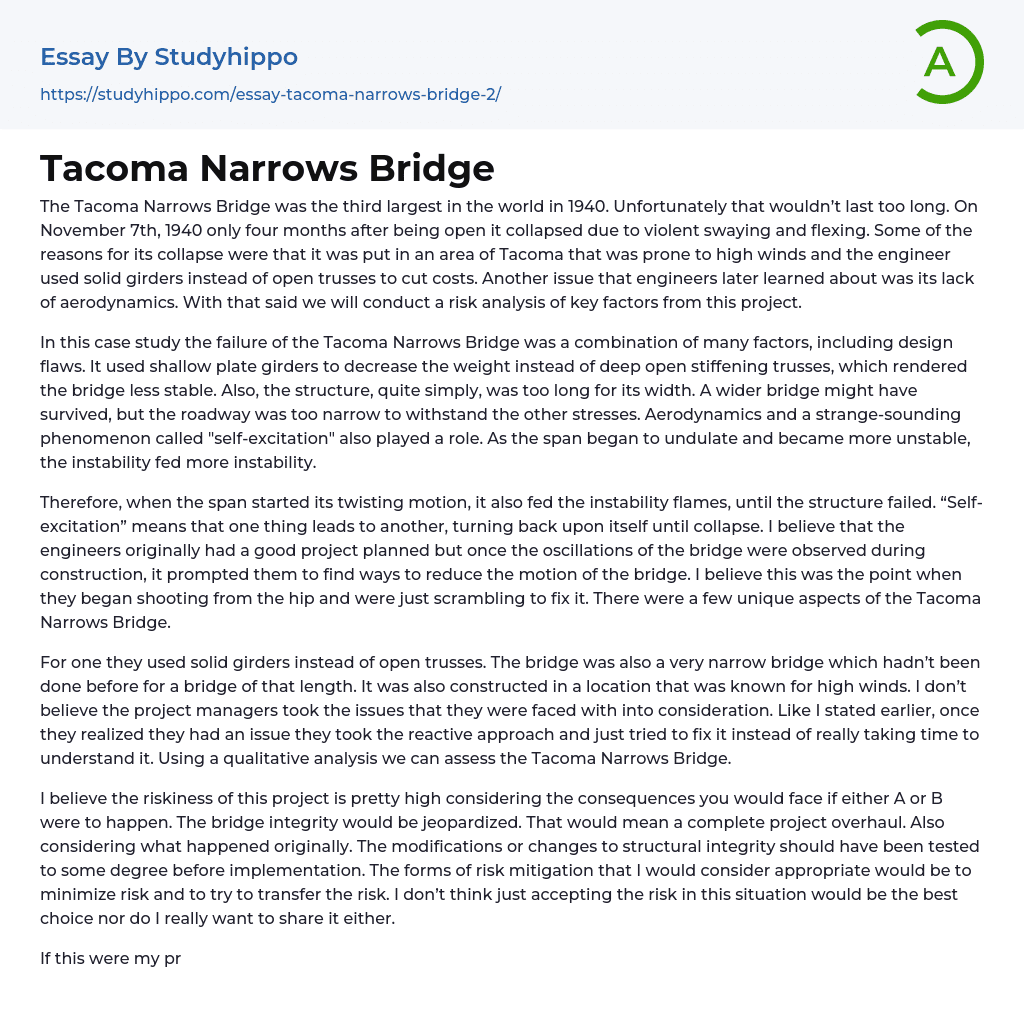The Tacoma Narrows Bridge was the third largest in the world in 1940. Unfortunately that wouldn’t last too long. On November 7th, 1940 only four months after being open it collapsed due to violent swaying and flexing. Some of the reasons for its collapse were that it was put in an area of Tacoma that was prone to high winds and the engineer used solid girders instead of open trusses to cut costs. Another issue that engineers later learned about was its lack of aerodynamics. With that said we will conduct a risk analysis of key factors from this project.
In this case study the failure of the Tacoma Narrows Bridge was a combination of many factors, including design flaws. It used shallow plate girders to decrease the weight instead of deep open stiffening trusses, which rendered the bridge l
...ess stable. Also, the structure, quite simply, was too long for its width. A wider bridge might have survived, but the roadway was too narrow to withstand the other stresses. Aerodynamics and a strange-sounding phenomenon called "self-excitation" also played a role. As the span began to undulate and became more unstable, the instability fed more instability.
Therefore, when the span started its twisting motion, it also fed the instability flames, until the structure failed. “Self-excitation” means that one thing leads to another, turning back upon itself until collapse. I believe that the engineers originally had a good project planned but once the oscillations of the bridge were observed during construction, it prompted them to find ways to reduce the motion of the bridge. I believe this was the point when they began
shooting from the hip and were just scrambling to fix it. There were a few unique aspects of the Tacoma Narrows Bridge.
For one they used solid girders instead of open trusses. The bridge was also a very narrow bridge which hadn’t been done before for a bridge of that length. It was also constructed in a location that was known for high winds. I don’t believe the project managers took the issues that they were faced with into consideration. Like I stated earlier, once they realized they had an issue they took the reactive approach and just tried to fix it instead of really taking time to understand it. Using a qualitative analysis we can assess the Tacoma Narrows Bridge.
I believe the riskiness of this project is pretty high considering the consequences you would face if either A or B were to happen. The bridge integrity would be jeopardized. That would mean a complete project overhaul. Also considering what happened originally. The modifications or changes to structural integrity should have been tested to some degree before implementation. The forms of risk mitigation that I would consider appropriate would be to minimize risk and to try to transfer the risk. I don’t think just accepting the risk in this situation would be the best choice nor do I really want to share it either.
If this were my project I would spend more time in the planning and discovery phase in order to prevent or minimize any risk to the project. For the sake of cost and cosmetics by using the solid girders the engineer used the straw that broke the
camel’s back.
- 12 Angry Men essays
- A beautiful mind essays
- A Separation essays
- Alfred Hitchcock essays
- American Beauty essays
- American Films essays
- Animation essays
- Avatar essays
- Blade Runner essays
- Bollywood essays
- Bond essays
- Bridge essays
- Cinema Of The United States essays
- Comedies essays
- David essays
- Dead Poets Society essays
- Do The Right Thing essays
- Documentary essays
- English-Language Films essays
- Erin Brockovich essays
- Film Analysis essays
- Film Editing essays
- Film Noir essays
- Film Techniques essays
- Finding Forrester essays
- Forrest Gump essays
- Gattaca essays
- Gladiator essays
- Glory essays
- Good Will Hunting essays
- Hamilton essays
- Hollywood essays
- Horror essays
- Jaws essays
- King kong essays
- Like Water For Chocolate essays
- Looking For Alibrandi essays
- Martin Scorsese essays
- Melodrama essays
- Monster essays
- Moulin rouge essays
- Movie Analysis essays
- Movie Review essays
- On The Waterfront essays
- One Flew Over The Cuckoo'S Nest essays
- Our day out essays
- Pearl Harbor (Movie) essays
- Persepolis essays
- Pornography essays
- Rabbit Proof Fence essays




